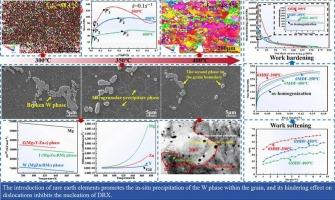多向锻造Mg-Zn-Gd-Y合金晶内析出、DRX与力学性能的相关性
IF 5.5
2区 材料科学
Q1 MATERIALS SCIENCE, CHARACTERIZATION & TESTING
引用次数: 0
摘要
研究了多向锻造(MDF)温度对Mg-5Zn-1Gd-1Y (ZGW511)合金动态析出、动态再结晶(DRX)、加工硬化和软化行为的影响。稀土元素的加入由于其阻力作用和低扩散系数限制了Zn的扩散,促进了原位晶内析出。具有较低吉布斯自由能的W相(Mg3Zn3RE2)优先发生动态析出。晶内析出W相对位错的钉住作用抑制了DRX的形核。锻造温度的升高促进了osterwald成熟,增大了W相颗粒,增强了W相颗粒的钉住作用,导致DRX体积分数逐渐降低。同时,位错密度的降低和晶粒尺寸的增大减弱了加工硬化和软化。晶内W相阻碍位错运动,引发位错局部积累,其周期性分布形成亚微米位错通道,有利于位错滑移的传递,导致∆σp/σ0随应力松弛循环次数的增加而增大。本文章由计算机程序翻译,如有差异,请以英文原文为准。

Correlation between intragranular precipitation, DRX, and mechanical properties in multi-directional forging Mg-Zn-Gd-Y alloys
This work investigates the effect of multi-directional forging (MDF) temperature on the dynamic precipitation, dynamic recrystallization (DRX), work hardening and softening behavior of Mg-5Zn-1Gd-1Y (ZGW511) alloy. The addition of rare earth (RE) elements restricts Zn diffusion due to their drag effect and low diffusivity, promoting in-situ intragranular precipitation. The W phase (Mg3Zn3RE2) with lower Gibbs free energy preferentially undergoes dynamic precipitation. And the pinning effect of the intragranular precipitated W phase on the dislocation inhibits the nucleation of DRX. Increasing forging temperature promotes Ostwald ripening, enlarging W phase particles and enhancing their pinning effect, leading to a gradual decrease in DRX volume fraction. Concurrently, the reduced dislocation density and increased grain size weaken work-hardening and softening. While the intragranular W phase hinders the dislocation motion and triggers local dislocation accumulation, its periodic distribution forms sub-micron dislocation channels that facilitate the transfer of dislocation slip, resulting in the increasing with the increasing number of stress relaxation cycles.
求助全文
通过发布文献求助,成功后即可免费获取论文全文。
去求助
来源期刊

Materials Characterization
工程技术-材料科学:表征与测试
CiteScore
7.60
自引率
8.50%
发文量
746
审稿时长
36 days
期刊介绍:
Materials Characterization features original articles and state-of-the-art reviews on theoretical and practical aspects of the structure and behaviour of materials.
The Journal focuses on all characterization techniques, including all forms of microscopy (light, electron, acoustic, etc.,) and analysis (especially microanalysis and surface analytical techniques). Developments in both this wide range of techniques and their application to the quantification of the microstructure of materials are essential facets of the Journal.
The Journal provides the Materials Scientist/Engineer with up-to-date information on many types of materials with an underlying theme of explaining the behavior of materials using novel approaches. Materials covered by the journal include:
Metals & Alloys
Ceramics
Nanomaterials
Biomedical materials
Optical materials
Composites
Natural Materials.
 求助内容:
求助内容: 应助结果提醒方式:
应助结果提醒方式:


